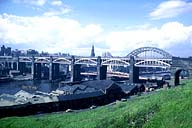
|
Image-GoddenB44
High Level Bridge. This historic bridge designed by Stephenson and completed in 1843 is one of the first tied-arch structures. Each span uses four iron 'Bowstring girders' devised by Stephenson for this bridge, the arch ties consisting of iron chains between the ends of each rib. A 2-level bridge, carrying a railway on the top level and road traffic on the suspended deck. (Newcastle, England)
|
|
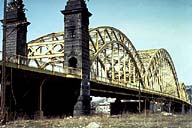
|
Image-GoddenB45
Bridge over the Allegheny River. This is a tied-arch highway bridge with overhead truss arches designed to take bending and shear as well as thrust. Compare this with the structures in GoddenB47-B50 which use a separate stiffening girder at road level. (Pittsburgh, Penn.)
|
|
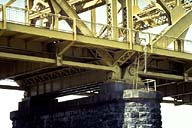
|
Image-GoddenB46
Detail of bridge over the Allegheny River. Twin bearings at one of the two river piers. Note that the arch spans are designed to behave quite independently. The steel ties in both spans can be seen. In the left span it is tied to a hinged bearing and in the right span to a hinged rocker bearing to allow for expansion. (Pittsburgh, Penn.)
|
|
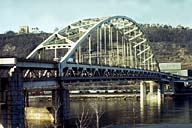
|
Image-GoddenB47
Fort Pitt Bridge. Tied-arch bridge in which the arch takes the thrust, and the stiffening truss at road level takes the moment, shear, and tension. Note the lateral bracing of the arch ribs overhead to resist wind loading and lateral buckling. (Pittsburgh, Penn.)
|
|
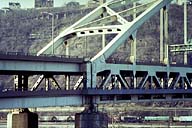
|
Image-GoddenB48
Fort Pitt Bridge. Detail of tied-arch bridge. Note that the arch rib is pinned to the top chord of the stiffening truss rather than at its mid-height. The tension thus applied to the top chord reduces the compressive force in this member due to positive bending. This is a double-deck bridge with road levels at the top and bottom chords. (Pittsburgh, Penn.)
|
|
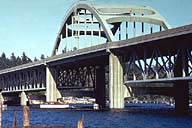
|
Image-GoddenB49
Tied-arch bridge at the end of a long floating bridge. As in the previous structure the arch rib itself is designed to take compression only and not bending or shear. The stiffening member to resist moment and shear is the girder at road level which also acts as the tie. (Seattle, Washington)
|
|
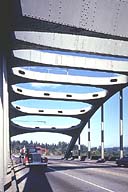
|
Image-GoddenB50
Detail of tied-arch bridge showing the overhead bracing between the arches. This bracing, which resists lateral buckling of the arches as well as wind forces, is designed as a vierendeel frame, with the maximum moments occurring at the joints with the arch ribs. Note the flaring of the transverse members to accommodate the variation in bending moment. (Seattle, Washington)
|
|









